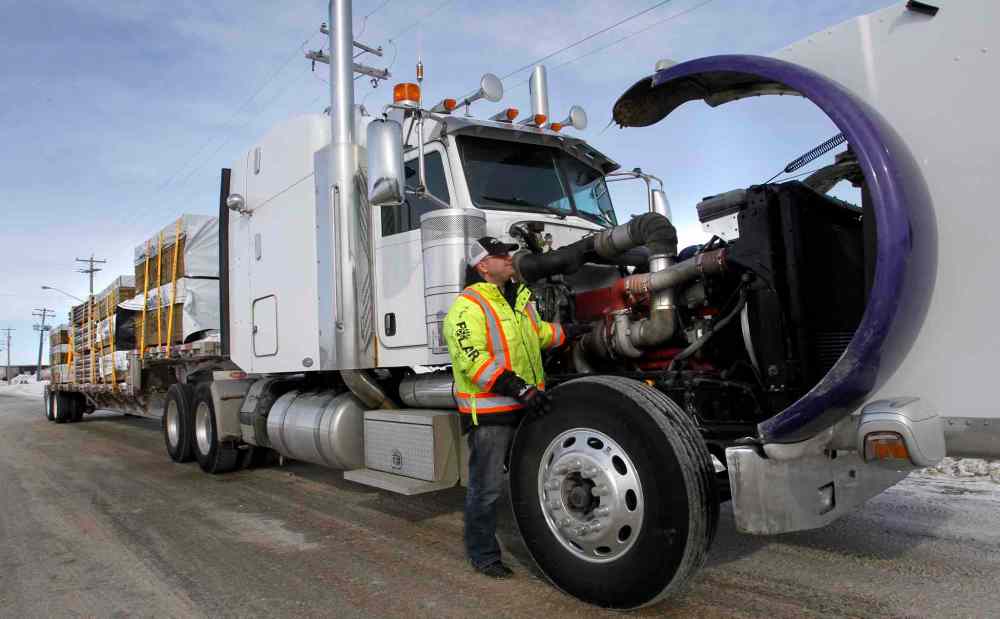Rigs ride risky lifeline of north
Truckers brave snow, ice and 'wave' to supply reserves
Advertisement
Read this article for free:
or
Already have an account? Log in here »
We need your support!
Local journalism needs your support!
As we navigate through unprecedented times, our journalists are working harder than ever to bring you the latest local updates to keep you safe and informed.
Now, more than ever, we need your support.
Starting at $15.99 plus taxes every four weeks you can access your Brandon Sun online and full access to all content as it appears on our website.
Subscribe Nowor call circulation directly at (204) 727-0527.
Your pledge helps to ensure we provide the news that matters most to your community!
To continue reading, please subscribe:
Add Brandon Sun access to your Free Press subscription for only an additional
$1 for the first 4 weeks*
*Your next subscription payment will increase by $1.00 and you will be charged $20.00 plus GST for four weeks. After four weeks, your payment will increase to $24.00 plus GST every four weeks.
Read unlimited articles for free today:
or
Already have an account? Log in here »
Hey there, time traveller!
This article was published 24/02/2014 (4315 days ago), so information in it may no longer be current.
The ice-road trucker pulls hard on the straps securing 21 tonnes of pipes and lumber to a flatbed and pops the hood on his rig for a final check. Then Kelly Ring offers a comment so obvious, even he had to smile: “These roads take a lot out of these trucks.”
Ring has been hauling building materials to northern Manitoba for four years and making a living out of one of the most dangerous jobs in the province.
A quiet man with a laid-back, easygoing nature, Ring has clocked thousands of kilometres driving into the teeth of the polar vortex this winter. He’s living inside his cab, and last week he left Winnipeg on his 11th run, destined for Garden Hill First Nation.

“It’s better than last year, much better. Looks like (Manitoba Infrastructure and Transportation) is doing a good job,” Ring tells a reporter. “The roads are smoother, wider and they’ve put in some bridges now… they’ve moved out some of the boulders. They used to destroy trucks.”
One thing that jumps out as Ring readies his rig for the frozen north: He’s not wearing boots. His choice of footwear is sneakers, not Sorels. There’s a reason: If you break through the ice, boots will weigh you down, maybe even drown you. He doesn’t even bother to mention it.
“We’ll stop for something to eat and head out,” Ring said, heading over to his buddy in a second semi that will make up his two-truck convoy.
This trip, one of about 25 Ring will make this season, will take him and his buddy on a convoy of two about 1,000 kilometres round trip, five days into the northern bush and back to their base at Polar Industries in Winnipeg.
They’ll take a long way around, from Norway House on an ice road, then north to Oxford House, then back south to Garden Hill. There is no other way.
By Sunday, the pair had run into a hitch, Ring’s boss reported.
“Last I heard, they were stuck yesterday morning north of Red Sucker Lake junction,” Polar Industries president Mark Kohaykewych relayed.
“Snow conditions have plugged the roads up. Guys getting stuck everywhere. Ontario is horrible right now. I have six guys out there that are crawling or at a standstill.”
Apart from the snow, Manitoba’s winter roads are in great shape, the gift of -40 C day after day early in the season that flash-froze the north.
Up north, snow is a hazard, ice an ally. A thick blanket softens ice, and that can sink a semi so deep in muskeg it’s like quicksand.
But on ice, a dynamic called “the wave” can crack an ice road and swallow a truck whole unless a driver knows what to do. The wave is the result of the weight of the trucks on the ice.
The only way past the wave is to keep it ahead of you. Shorelines are the tricky part. Waves hit the land, and if you’re slow and easy at the wheel, you’ll surf over it and safely top the bank, even with a full load.
Manitoba decommissioned a stretch of winter road four years ago when melt after melt turned a so-so link to Pauingassi into a mud pit.
Since then, a Manitoba Conservation priority to protect caribou has also served to spare truckers a frozen kind of hell that melts into slush without warning.
This year, Manitoba Infrastructure and Transportation has manned snowplows up and down the east side of Lake Winnipeg nearly 24/7 to beat back the melt.
“MIT is working around the clock to blow the great amount of snow and keep the roads safe for us,” Kohaykewych said.

Every stick of lumber, every pound of butter going into the north relies on the province’s 2,300-kilometre ice-road network, which is open an average of eight weeks a year.
“By comparison, we’re a little bit better than last year by a few days,” said Larry Halayko, the director of contract services for MIT. “We had about a half a week head start compared to last year, but when we’re talking about an eight-week season, that’s a lot.”
There are two kinds of commercial freight on Manitoba’s ice roads. The first is the kind that Kelly does, which is hauling building materials. That is a drama that draws cameras and film crews from TV series such as Ice Road Truckers.
The second is about food, rifles, couches and snowmobiles.
“We use the roads extensively. We have 16 communities tied to winter roads, with stores in each of them,” said Pat Jacob, inland region general manager for the Northwest Company, the corporate parent for the Northern Stores.
That network is as much a lifeline for the north — and a lightning rod for complaints — as winter roads themselves.
The province’s winter-road network is the only road link to the south for dozens of First Nations and small towns that dot the muskeg and hug the north’s many lakes and rivers.
“This year, it’s been great,” Jacob said. “We opened up for heavy traffic a week to 10 days earlier than last year, and last year was a good year. This one is even better.”
Two years ago, the frigid cold never arrived this far south. This year, the polar vortex pinned the continent down from Hudson Bay to the Gulf of Mexico. Between the two extremes, the province is steering a future course away from ice roads.
Ernie Gilroy, the boss of the East Side Road Authority, sees the day when winter roads are history, at least on the east side of Lake Winnipeg.
By this fall, the first stretch of all-season road between Hollow Water and Bloodvein First Nations will have its official grand opening.
“The idea is we’re going to convert most of the winter roads to pioneer roads, which is a lower standard than gravel roads, but over time they will be converted to use all season round,” Gilroy said.
alexandra.paul@freepress.mb.ca
